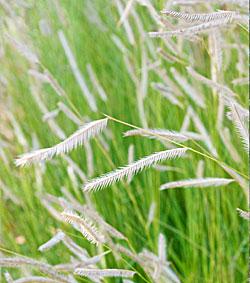Water-Efficient Landscape Gardens in September
Home » Fair Oaks Horticulture Center » WEL Gardens » September in the WEL
The WEL gardens at the Fair Oaks Horticulture Center are open to the public seven days a week from sunrise to sunset for self-guided tours.
Wheelchair accessible, the gardens feature natives, commonly available perennials, trees, shrubs, and plants from other Mediterranean climates that do well with less water during our long, hot, dry summers and tolerate our chilly, damp Sacramento County winters. Most plants are labeled and many are UC Davis Arboretum All-Stars. The landscape demonstrates how home gardeners can be smart about using the water we have to create beautiful landscapes. Click here for resources about gardening with limited water.
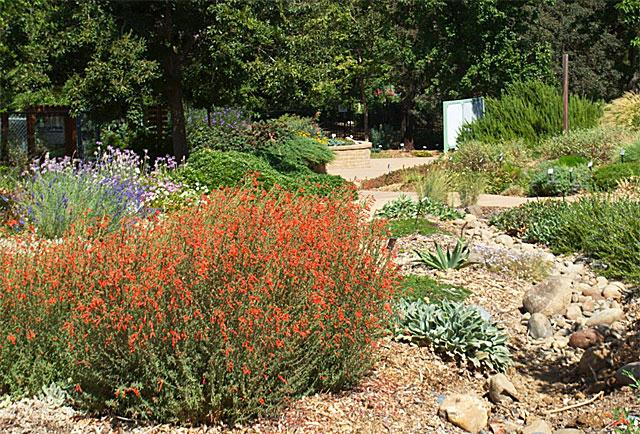
Late summer and early fall lovelies start to shimmer and dance as the sun drifts lower across the sky. The backlit ornamental bunch grasses wave red, soft green, gold, wheat, tan, beige, and ocher plumes throughout the garden. Especially lovely are the deer grass, love grass, ‘Little Kitten’ dwarf eulalia grass and blue grama grass. Grasses serve many purposes in the garden. Tall grasses, such as feather reed grass make good screens, and medium height grasses such as deer grass work well to fill in backgrounds or borders. Small arching fescue grasses and sedges do well as companion plants and ground covers. Ornamental grasses often work well as accent and focal plants while many fescues, grama grasses and sedges can be used as lawn substitutes. Most grasses once established require little irrigation, no fertilization and are low maintenance. See more information on ornamental grasses (PDF).
Other late summer standouts include the charming small grass-like zephyr lily blooming with white open petaled blossoms, flowing yellow and white lantana, the many varieties of Autumn sage, late blooming English lavender and Russian sage. Hummingbirds, carpenter bees, butterflies, hover flies and other beneficial insects blissfully float about the late blooming orange California fuchsia, lavender pitcher sage, roses and butterfly bush. Our resident mockingbird, scrub jays and visiting bush tits and other birds are feasting on tidbits of coffeeberry, Oregon grape holly, aphids, spiders and more.
Garden chores this month include continuing to monitor weeds. (The Weed Identification Photo Gallery is a good guide to identifying and controlling weeds.) We will deadhead some of the salvias to prolong bloom. Many of the Autumn sages such as ‘Hot Lips’ rebloom vigorously after removal of spent flower stalks. Another project will be reviewing plants in the garden that have not done as well with our water restrictions and to plan for fall replacements.
September is also the time to continue to monitor for pests. Since pests tend to be specific to a plant it is important to identify the pests before determining a management plan. In many cases spraying a pest off the plant with water, picking it off and dropping it in a pail of sudsy water or deciding to live with the small amount of damage is the correct course of action. Often, the good bugs and birds are able to control minor infestations. (A good resource for flower pest management and cultural care is the UC Integrated Pest Management website on flowers).
Irrigation lines, connectors and emitters will be checked for clogs, cuts and breaks regularly and schedules will be monitored. As the days shorten and cool off earlier, irrigation times will be reduced. (See more irrigation tips.)
Come check out the garden. In addition to the plants, pathways, patios, raised planters, drip irrigation, a dry creek bed and permeable pavement demonstrate water wise, sustainable alternatives for gardeners who are considering replacing or reducing their lawns.
| Bouteloua gracilis |
|
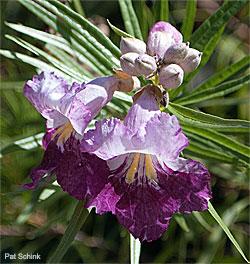
|
Chilopsis linearis 'Timeless Beauty' The desert willow is a fast growing deciduous multi-stemmed tree native to the southwest United States and northern Mexico. This sun lover with lovely bicolored pink and burgundy flowers that bloom from spring to fall is a “show stopper” at the entrance to the perennial walk during our August Harvest Day event. Hummingbirds and bees are attracted to the prolific blooms. Timeless Beauty is a sterile variety that does not set seed and blooms over a longer season (spring into fall!) than varieties that do set seed. Named for willow-like leaves, it can grow to 18 feet tall and 15 feet wide in well drained soil. |
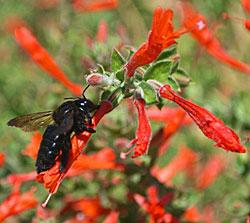
|
Epilobium canum An easy-to-grow California native that tolerates heat, drought and poor soils (although it prefers good drainage), the California fuchsia welcomes bees, hummingbirds and beneficial insects to our garden. It is available in many varieties from aggressive mat-forming ground covers to 3 to 4 foot subshrubs with tubular blossoms of white, pink, orange and red and narrow to broad leaves ranging from gray to lime green. Once established the plants should be cut to the ground in late fall after blooming ends. We have several varieties growing in our garden. Near the entrance is the low growing gray, round leaved Epilobium canum ‘Calistoga’. Along the dry creek bed at the back of the common variety area is a taller growing, bright green leafed variety, while the entrance to the native garden is graced by a similar, but lower growing groundcover variety. A UC Davis Arboretum All-Star selection. |
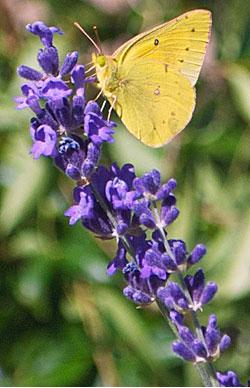
|
Lavandula angustifolia ‘Hidcote Blue’ Lavandula angustifolia, a native lavender of the mountains of the southern Mediterranean, not England as its common name implies, is a charming member of the mint family. The fragrant flowers and leaves are often dried and used in potpourris and cooking. Lavenders work well in borders as long as they have well drained soil and plenty of sun. Once established, they do well with low water and little or no fertilizer. The gray-green leaves provide a cooling, calming contrast to many bright companion flowers and leaves. The flowers attract butterflies and other beneficials. While there are dozens of cultivars of L. angustifolia, ‘Hidcote Blue’ is an especially nice one. Reaching about 18 inches high with brilliant dark blue-lavender flower spikes, it tends to re-bloom in late summer if deadheaded after the initial flush of early summer bloom. Plants will become woody and need replacement after a few years if they are not pruned back by half or more every year after they complete blooming. This will keep the plant compact and neat and encourage more profuse flower stalks. |
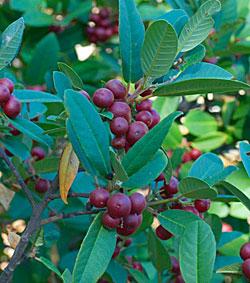
|
Rhamnus californica ‘Eve Case’ Coffeeberry This evergreen native shrub of the California coast from Oregon to Baja adapts well to our Sacramento soil and climate. The olive green leaves are held by burgundy stems which bear yellow green spring flowers that provide nectar for pollinators. Berries, colored green to red then black through fall, provide food for birds and other wildlife. ‘Eve Case’ will grow in sun or part shade and while it prefers good drainage, it grows well in our clay soil. It is a good choice for a foundation shrub or hedge. In Sacramento, it grows 6 to 8 feet high and wide. It tolerates selective pruning. |
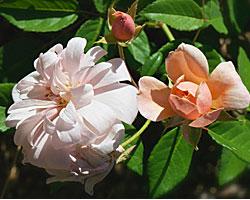
|
Rosa 'Perle d'Or' Dating from 1884, this drought tolerant, virtually pest free relatively thornless, fragrant shrub rose sports clusters of apricot colored blossoms almost year round. Another UC Davis Arboretum All-Star, it requires full sun and pruning to shape in the winter. |
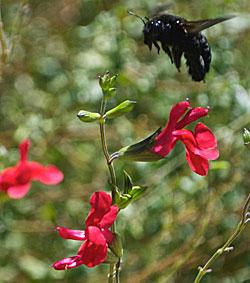
|
Salvia greggii ‘Hot Lips’, ‘Lipstick’ Commonly called Autumn sage, these evergreen members of the sage family with charming red, pink, red and white blooms (depending upon variety) start blooming in spring and often bloom non-stop through fall, especially if spent flower stalks are pruned back. They typically grow 1 to 4 feet tall and wide. If properly sited in full sun or part shade, they are practically "goof proof," easy care, drought tolerant plants that attract hummingbirds, bees and other beneficial insects. They can be pruned in late winter to keep compact. |
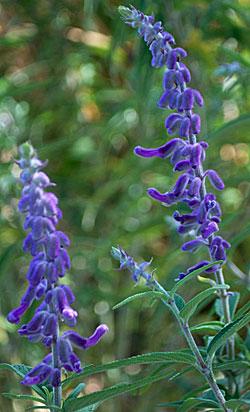
|
Salvia leucantha ‘Santa Barbara’ Also known as velvet sage, S. leucantha is a native of eastern and central Mexico. A moderate sized late summer/fall blooming perennial star in our far parking lot bed, it will bloom abundantly from late summer until the first frost especially if spent blossoms are removed just as they begin to fade. The size (2-1/2 feet tall and 4 feet wide) of our ’Santa Barbara’ cultivar is not as large as many other varieties. Very drought tolerant once established, the soft grayish green leaves set off brilliant purple flower stalks that make good cut and dried flowers. Plant in full sun, well drained soil and reduce summer watering for the best bloom. Mexican bush sage will die back to the ground in winter and may not survive a severe frost. If it does not die back during a mild winter, the plant should be cut close to the ground before spring growth begins to maintain a more compact shape and control flopping flower stems. |
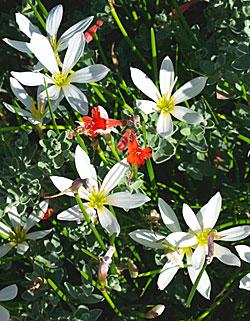
|
Zephyranthes candida This cheery white flower blooms in late summer. Growing from bulbs that form small clumps of low growing shiny, grassy leaves it makes a good edging plant or groundcover. Once established, they require little water or pruning. Preferring full sun, it will handle small amounts of shade and also grows well in pots. Here it is pictured with another late summer bloomer, a low growing California Fuchsia. A UC Davis Arboretum All-Star selection. |




